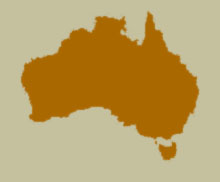Synonyms
Serangium mysticum Blackburn, 1889: 210.
Serangium hirtuosum Blackburn, 1892: 73.
Serangium nigrum Lea, 1902: 510.
Serangium maestum Lea, 1902: 511.
Diagnosis
This is a very distinctive species due to the relatively uniform and dense dorsal pubescence, the uncoloured elytra and the grooved last abdominal ventrite.
Description
Length 1.7-2.1. Head brown or black; pronotum pitch black or dark brown; elytra dark brown, often lighter than pronotum; almost black ventrally; trochanter brown, tarsi dirty yellowish. Winged; body shape hemispherical (Figs 94, 95); pronotal margins without rim, hardly visible from above; elytra with inconspicuous swelling near humeral edge; elytral margins with distinct rim, visible over all their length. Head, pronotal and elytral surface shiny, finely punctate and conspicuously covered in long setae. Scutellum elongate, triangular, flat, shiny, glabrous, with a few fine punctures. Head with moderately large eyes, separated by 2.3 times eye width; flattened medially. Clypeus flat, long, weakly curved anteriorly. Terminal maxillary palpomere relatively narrow, oval, subacute apically, terminal labial palpomere narrow and aciculate. Antenna (Fig. 18) 9-segmented, scape expanded apically, club elongate, inner margin convex, apex angular. Prosternum mat, with fine punctures associated with sparse setae; mesosternum mat, punctate with associated sparse setae; metasternum shiny in the middle, mat along margins, with coarse punctures along coxal insertions and laterally, otherwise finely punctured with fine associated setae. Elytral epipleuron brown, broad, excavate and perpendicular to elytron in anterior half, with some long setae, narrowing to apex but present throughout. Anterior margin of profemur strongly angled slightly beyond the middle. Tarsus 4-segmented. Abdomen: ventrite 1 large, shiny, finely punctate with long associated setae; ventrites 2-5 small, shiny, coarsely punctured and bearing long associated setae. Last ventrite grooved laterally.
Male
Male genitalia as figured.
Female
Externally identical to male.
Variation
There is considerable variation in colour of dorsum from reddish brown to black.
 Distribution and Biology
Distribution and Biology
Distributed all over Australia.
Species References
Blackburn, T. 1889. Further notes on Australian Coleoptera, with descriptions of new species. Transactions of the Royal Society of South Australia, 11: 175-214.
Blackburn, T. 1892. Further notes on Australian Coleoptera, with descriptions of new genera and species. XI. Transactions of the Royal Society of South Australia, 15: 20-73.
Lea, A.M. 1902. Descriptions of new species of Australian Coleoptera. Part VI. Proceedings of the Linnean Society of New South Wales, 1901: 481-513.
Slipinski, A. and Burckhardt, D. 2006. Revision of the Australian Coccinellidae (Coccinellidae). Part 5. Tribe Serangiini. Annales Zoologici (Warszawa), 56(1): 37-58.
[ Top ]
